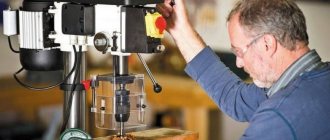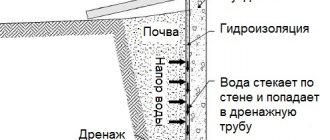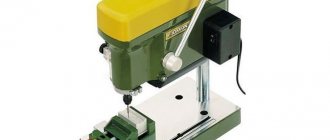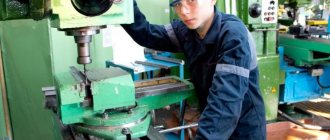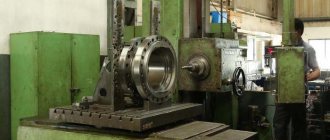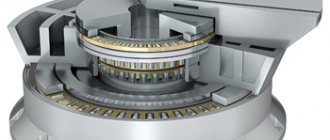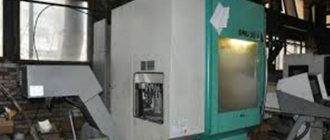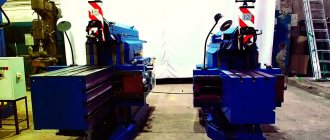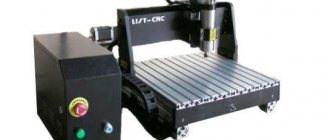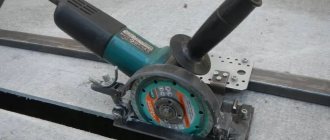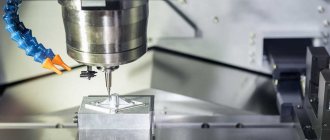A drilling machine is a device used to form holes in parts made of various materials. The technical capabilities of modern machines of this category allow them to be used not only for creating holes with a diameter of up to 100 mm, but also for performing a whole list of other technological operations.
For any type of activity, you can choose a suitable drilling machine, be it a home workshop, a car service or a production workshop.
Application, design and operating principle of drilling machines
Drilling machines allow you to create through or blind holes in parts made of various materials. These technological operations are performed using a cutting tool such as a drill, which ensures the removal of chips from the material being processed.
Most devices of this type are industrial drilling machines. The number of models for home use, characterized by significantly lower functionality compared to professional devices, is insignificant. Meanwhile, it is by the example of the simple design of household models that it is most convenient to get acquainted with the principle of operation of a drilling machine and its basic elements.
Small-sized household drilling machine
A household model is, as a rule, a tabletop drilling machine, which has compact dimensions and is installed on the surface of a workbench or on any other elevation that makes it easy to use. In the vast majority of cases, this is a vertical drilling machine, the design of which is the most typical for equipment of this type.
The basic elements of a drilling machine used both at home and in domestic conditions are:
- a spindle head in which a working chuck is mounted, which serves to fix the cutting tool;
- drilling head, the design of which includes a spindle head, an electric drive motor and a belt drive;
- supporting column-column on which the drilling head of the equipment is mounted;
- a massive base plate made by casting from steel or cast iron (it performs two functions: it serves as a reliable base for the machine and is used to secure the vertical equipment stand).
Main components of a drilling machine
The technological operations for which the vertical drilling machine is intended are performed through two movements of the spindle: main and auxiliary. The first movement is the rotation of the spindle assembly, and the second is its movement in the vertical direction. The vertical drilling machine got its name because its spindle makes a feed movement in the vertical direction. A special steering wheel located on the side of the device’s body is responsible for performing such a movement.
Characteristics
When choosing equipment, it is necessary to select the correct machine layout and technical characteristics according to the planned work.
- Machine type. When processing large and heavy workpieces, radial drilling is more suitable; for small workpieces, vertical drilling is more suitable.
- Power. The performance and energy consumption directly depend on this parameter.
- Supply voltage. 220 V - small hobby-class equipment, 380 V - professional machines.
- Maximum drilling diameter. This parameter characterizes the maximum drilling diameter in steel 45.
- Spindle speed. Depends on the machine gearbox and, depending on the equipment, can be 2000 - 3000 min
-1. Different materials are processed at different rotation speeds.
Design elements of household drilling equipment and their interaction
The spindle assembly of both industrial and household drilling machines is driven by an electric motor that imparts torque to the belt drive shaft. Drilling machines intended for domestic use are equipped with electric motors with a power of 250–1000 W.
Asynchronous motor of the Sturm BD7037 desktop drilling machine with a power of 370 W
On many models of household drilling machines, the rotation speed of the cutting tool can be adjusted, which is ensured by the use of belt drive shafts of different diameters in their design. The principle of regulating the spindle rotation speed on such machines is quite simple: when the drive motor is turned off, the belt is simply thrown into the groove of that part of the pulley that has a different diameter. Using this principle, the spindle speed can be adjusted in the range of 450–3000 rpm.
Belt drive unit for Proma PTB-16B230 machine
Machine tools for domestic use are usually equipped with drill chucks identical to the clamping devices of hand-held electric drills. These chucks with 3 self-centering jaws are designed to hold drills with a diameter of up to 12 mm. To work with this chuck, you need a special key, which is used to clamp or loosen the locking jaws.
When choosing a machine, pay attention to the minimum diameter of the drill clamped in the chuck - the jaws of some models cannot fix drills with a caliber of less than 3 mm
The technical capabilities of drilling machines for household use make it possible to process parts whose height is in the range of 200–900 mm. This parameter depends on the height to which the drilling head can be raised on the equipment rack. The principle of moving the drilling head along the machine column may vary for different models. On the simplest and lightest devices, the working head is moved to the required height manually, and on larger and heavier equipment, a special steering wheel handle is provided for this, which is connected to the drive mechanism.
A special handle is used to fix the drilling head in the required position and to set it at the required height before starting processing. It is necessary to adjust and fix the position of the working head before starting drilling because the amount of protrusion of the chuck from the spindle assembly is quite small and, depending on the model of the unit, is 50–400 mm.
Controls for adjusting the drilling depth of the NS12A machine: 1 – indicator nut; 2 – pointer protrusion; 3 – steering wheel; 4 – clamp; 5 – fixing screw; 6 – spindle sleeve
An important parameter by which any drilling machine is evaluated is drill overhang. This parameter, which can be in the range of 100–200 mm for different models of household machines, characterizes the distance from the axis of rotation of the cutting tool to the axis of the rack-column (it determines at what distance from the edge of the part a hole can be drilled).
The main requirement for the base plate of a drilling machine, which must ensure its stable position on any horizontal surface, is its massiveness and dimensions sufficient to balance the mass of the other structural elements of the equipment.
The purpose of the upper part of such a plate is to serve as a work table, so it is made as flat as possible with several grooves. The central of these grooves is used when drilling through holes and is necessary in order to avoid damage to the drill and the surface of the work table during such a technological operation. The remaining grooves on the surface of the work table are needed to secure various clamping devices.
The base of the PROHHON-TBM-220 machine has slots for attaching a vice
The vertical movement of the drill fixed in the chuck is carried out by a lever mechanism driven by a special handle. This handle, located on the side surface of the machine body, is specially spring-loaded, which ensures that it automatically returns to its original state after the impact on it stops.
The electric motor on household models is powered primarily from an electrical network with a voltage of 220 V. It starts and stops using a push-button station. On certain models of household drilling machines, the technical capabilities of which allow cutting internal threads, reverse starting of the electric motor is provided.
Price of units
The cost of the issue is very pressing, given the latest trends with prices and currency fluctuations. In general, to say that the price of a machine is high or affordable is wrong.
The price of a machine depends, oddly enough, on the size, complexity of the device, whether CNC is present or not, imported equipment or from a CIS country.
The asking price for a machine for home/desktop use ranges from 7,000 to 150,000 rubles.
The spread is too huge, the average price for the category is 30,000-50,000 rubles, for which you will get an excellent machine for long-term use.
There is no need to overpay for a brand and especially for options that you cannot use or that are not useful at all.
Another thing is the price of professional solutions: from 150,000 rubles to several thousand euros, depending on the functionality.
The main characteristic that you should pay attention to when purchasing is the working range along the planes.
It is important if you want to work with complex parts. Just be prepared to fork out the cash for it.
Accessories for household drilling machines
A tabletop drilling machine intended for use at home can be equipped with additional devices that significantly increase its functionality and ergonomics.
Machine "Caliber SS-13" with an additional lifting work table
Let's list such devices.
- The work table, which is mounted on a cantilever stand, allows you to perform various actions with it: raise and lower it manually (in the simplest models of machines); use a special handle connected to a rack and pinion mechanism to change the height of its location; fix at the required height. Some models of drilling machines for home can be equipped with a work table, which can not only move in the vertical direction, but also rotate about the vertical axis.
- The mechanism that provides adjustment of the drilling depth operates on the following principle: the tip of the drill, fixed in the equipment chuck, is lowered to a mark on the side surface of the part corresponding to the required drilling depth. After this, tighten the tightening lever of the depth regulator, thereby limiting the stroke of the cutting tool.
- The protective screen, which is a folding guard made of transparent plastic, protects the machine operator from flying chips and prevents clothing and long hair from entering the processing area.
Quick release clamp for drilling machine BOSCH PBD 40
CNC: classification and explanations
Today CNC is used everywhere in machine tools, with the only caveat that it is strictly for technological needs: if it is possible to make a part, and there are no requirements for super-precision of its execution, you can simply invite an experienced craftsman to work on it, who will carry it out on a familiar manual machine.
Although for home work (for jewelers, wood and metal artists) there is a miniature tabletop machine, it is no less professional and reliable.
Video:
So the price and the question of appropriateness, although banal, are vital. Technologically, the CNC system can be divided into 2 groups:
- Positional: the drill and the workpiece move intermittently - point by point. In this case, the positions are either far away (say, when boring and drilling), or close to each other (as when turning and milling);
- Continuous movement: contour work in one movement.
The CNC positional system is the simplest type of control, but is used mainly in drilling and jig boring machines, where shaped movement is not required - only in a straight line.
The rectangular CNC system moves the drill one at a time along a specific coordinate axis, while the speed of movement is set by the program itself.
This system is also used to a limited extent (comparatively) on workpieces that can be placed parallel to the coordinate axes (turning, milling).
CNC shaping
This type of CNC needs to be discussed separately. This is a more advanced option for positioning and work in general, since the tool moves along two or more coordinates, which allows processing workpieces of any shape.
The interpolator simultaneously produces coordinates in three-dimensional space in the form of a certain number of feed drives. Today, more and more machines are being produced with CNC shaping.
Video:
Yes, they are expensive, but such professional equipment quickly pays for itself, as it allows you to produce complex parts that are not cheap.
But even such an innovative machine can offer a choice of options: 2D and 3D shaping.
2D shaping is controlled along two coordinate axes, which means you can move the drill along an arc and a straight line. A particular version of this type is 2½D shaping.
IMPORTANT TO KNOW: Operation of CNC milling machines for metal
The drill already moves along 3 coordinate axes, but the difference is that only 2 axes are controlled, and the third is used for installation, approach and retraction of the tool.
After executing a command to move in a certain plane, the system can switch to movement in another.
The current processing plane, coupled with the simultaneous control of different axes, allows the drill to operate in the XY, XZ, YZ planes.
This CNC system is used in simple machines that are equipped with a stepper feed drive.
What is noteworthy is that complex contours and surfaces can be processed on the machine, but a volumetric part is processed layer by layer in a specific vertical or horizontal plane, and not continuously.
3D shaping is the crown of machine tool engineering, which produces high-precision parts with a smooth surface.
Video:
The machine tool moves along 3 axes at once, which means you can process any spatial contour continuously. For the most part, the milling method is used rather than drilling.
However, if the machine is universal, and even with 3D, then it will perform any part, not to mention ordinary drilling. The price of such a unit sometimes reaches several thousand euros.
Drilling machines for industrial use
It is enough to look at the drawings or photos of industrial drilling machines to understand that they are much more complex devices than household models. Most of the models of such machines are universal equipment that allows you to perform not only drilling in metal and other materials, but also a number of other technological operations.
Multi-spindle drilling machine GILLARDON RF 25
Production drilling machines include devices of the following categories.
Tabletop machines
Such machines are small in size and light in weight. They are used for drilling holes with a small diameter.
Vertical drilling (column) machines
These machines are used to equip small-scale and individual production. With their help, you can make holes in metal workpieces with a diameter in the range of 18–75 mm.
Radial drilling machines
This equipment is used for processing massive metal parts or workpieces in which it is necessary to form holes with centers located along a circular arc. The design of a drilling machine in this category is characterized by a fairly large overhang of the spindle unit, the value of which can reach 1300–2000 mm.
Coordinate drilling devices
The use of such machines is relevant in cases where high demands are placed on the accuracy of the location of several holes in a part.
Horizontal drilling machines
These devices process holes of significant depth (shafts, axles, rods, etc.).
Centering machines
Such equipment is used to form center holes located at the ends of the workpieces.
Multi-spindle machines
On units equipped with several spindle heads, multiple holes located in vertical, horizontal and inclined planes can be processed simultaneously.
Combined machines
On devices of drilling-milling, drilling-turning, drilling-slotting and a number of other categories, various technological operations can be simultaneously performed.
Universal drilling and milling machine Stalex-LM1450-2
The most common are vertical and horizontal drilling machines. Many modern models of drilling machines are equipped with numerical control systems, which can significantly increase the productivity of such equipment and ensure high processing accuracy. Machines with such a control system are used primarily to equip serial and large-scale production enterprises.
Among the special drilling equipment, mention should be made of magnetic machines, which are used to make holes in large parts. Such devices, equipped with a special magnetic base, are placed directly on the surface of the workpiece and are securely held on it due to a powerful magnetic field. The big advantage of machines in this category is that they can be located in any spatial position.
The unique design of magnetic machines makes it possible to process metal where it is impossible to do with conventional equipment
Despite the fact that any drilling machine can be used to make holes in workpieces made of various materials, special models are created for woodworking and furniture factories that can be equipped with one or more spindles, including rotary-type working heads. Using such equipment, you can not only make holes in wood parts, but also create nests, grooves, and remove knots.
The use of modern drilling and filler equipment in furniture factories, which has great versatility and functionality, allows it to quickly produce furniture structures even according to the most complex drawings.
Designation
The letters and numbers in the markings can tell, if not everything, then a lot about the equipment. The abbreviation will tell a specialist who works with metal machines about its main characteristics.
The alphanumeric designation on the housing indicates:
- the first digit - into groups according to the table of classification of metalworking equipment;
- the second digit indicates the type of equipment;
- if a letter is indicated in second place, then this indicates a modernization of the base model;
- The maximum drilling diameter in mm is determined by the value of the last 2 digits.
- if at the end there are the letters “N”, “P”, “B”, “A”, “C”, then they indicate accuracy, “M” - a magazine with interchangeable tools.
Classification of machines according to ENIMS
Modernized CNC machines are marked with the letter “F” and a number in front of the type. The meaning of the number indicates:
- the machine has a digital display and a preliminary set of coordinates. The purpose of this system is to ensure that, after completing one of the specified cycles, the machine stops. To start the next operation, you must press the button. The programmed device will automatically move the drill to the required position. The movement of the tools is programmed by recording the actions on punched tape.
- The machine is equipped with positional and rectangular CNCs. The purpose of this system is to simultaneously place from 1 to 5 tools in the working position.
- CNC contour systems. The pulse signal determines the required distance to move the tool to a given point.
- universal CNC system.
Capabilities and design of industrial drilling equipment
Drilling equipment intended for industrial use is much more complex than domestic models. This is noticeable, as mentioned above, even from photos of such units. Feeding of cutting tools on this equipment can be performed not only manually, but also in automatic mode. Almost any of these machines provides the ability to regulate the rotation speed of the spindle unit and the feed rate, for which the speed box and feed box are responsible, respectively.
Professional-class benchtop drilling machines differ from household models in high-precision components, from support bearings to chucks
Since such machines are used more intensively and for solving critical tasks, their kinematic design is more complex and reliable. Many of the modern models of these devices provide the option of automatically reversing the direction of feed and rotation of the cutting tool at the moment when it reaches the required processing depth.
The spindle assembly of most models of such equipment is equipped with a mechanism for automatically approaching the surface of the workpiece. An almost mandatory option for these machines is the automatic supply of coolant to the processing zone at the moment such processing begins.
Drilling head design of an industrial machine
Recently, industrial enterprises have been actively equipped with drilling machines, the operation of which is controlled by a CNC system. The advantage of using such equipment is that they automate the main and auxiliary technological operations, which can significantly increase their productivity compared to manually controlled models.
Industrial drilling machines, as mentioned above, are capable of performing various technological operations:
- opening holes;
- processing of holes using a countersink;
- chamfering in the upper part of the holes, forming cylindrical and conical recesses - countersinking;
- processing of holes using counterbore;
- internal thread cutting;
- processing of holes using a cutter - boring;
- finishing of holes using ball or roller tools - smoothing;
- processing of parts using milling tools (forming grooves, etc.).
Countersinking a recess on an industrial machine
Design features
There is simply a huge amount of different drilling equipment, they all have their own design features. Vertical layout models are the most widespread. The classic design of a vertical machine consists of the following elements:
- The spindle head is designed to accommodate the working chuck in which the cutting tool will be fixed. The device can operate at different speeds.
- The spindle is part of the drill head, which also includes a belt drive and an electric motor that drives the cutting tool. The belt drive allows you to regulate the number of revolutions and also protect the electric motor from overload. In addition, the drive can be made in the form of a combination of sprockets and gears.
- The headstock is mounted on a supporting post, which is made using high-strength metal. When creating a rack, most attention is paid to rigidity.
- The entire structure is based on a massive slab. It is made from steel or cast iron by casting.
- The scheme provides for the presence of a gearbox. It allows you to adjust the rotation speed of the cutting tool. Almost all technological maps for the manufacture of various products indicate at what speed the processing should be carried out.
- The control panel may consist of various keys and toggle switches. Recently, more often there are models of machines with an installed touch screen, through which the basic parameters are set.
- The design of modern drilling machines also includes protective glass made from materials with increased resistance to mechanical stress.
Each unit must be thoroughly checked before starting work.
This is interesting: Welding inverter Resanta SAI-220: characteristics, diagrams, customer reviews
Rules for working on a drilling machine
Operating drilling equipment may pose a risk of injury to the operator if safety requirements are not followed. In particular, the following may pose a risk to the health and even life of the operator working on the drilling unit:
- machine elements that rotate and move linearly during processing;
- conductive elements;
- workpieces and tools that, if not securely fixed, can fly out of the processing area.
The most important safety requirement for working with drilling equipment is the use of technically sound and proven devices and tools (and only for their intended purpose).
The cutting tool is of great importance for the proper operation of the machine and the production of high-quality holes with its help. It must be well and correctly sharpened, and also selected in accordance with the material of the part in which the holes need to be drilled. During processing, the cutting tool heats up intensely, which can lead to rapid wear and failure. To minimize this risk, during processing it is necessary to cool the tool using a special liquid or ordinary water.
The process of drilling holes whose depth is greater than 5 diameters of the tool used has some peculiarities. During the process of forming such holes, the tool should be periodically removed and the unfinished hole freed from accumulated chips, which can lead to jamming of the drill.
In general, the technique of working with drilling equipment and the rules for its regular preventive maintenance do not cause any great difficulties; you can learn them quite quickly. If these rules are followed, the equipment will serve you for a long time, and you will be able to use it effectively to produce accurate and high-quality holes.
Operations carried out
Industrial machines of this type can be used to carry out a wide variety of operations. This is due to the fact that in addition to the drill, other tools can be installed. Most often, the equipment is used to perform the following operations:
- Processing of already obtained holes using counterbore.
- Deployment.
- Processing when using a countersink punch.
- Formation of threads inside holes.
- Boring of holes using the appropriate cutter.
- Finishing processing.
- Formation of various recesses when installing a milling tool.
Household models are suitable exclusively for drilling and reaming.
It is quite important to choose the right drill depending on the type of metal from which the workpieces are made.
A material that is too hard can cause rapid wear of the cutting edge.
Operating principle
When choosing a drilling machine, you should take into account what kind of work will be performed. The vertical orientation device is suitable for most drilling operations.
The operating principle of such machines has the following features:
- The workpiece is mounted on the table. During machining, the quality of the workpiece clamping determines how accurate the hole will be. The desktop version may be without a device for fastening the workpiece; fixation is carried out when using metalworking machines.
- The device is connected to an energy source. Household versions can operate from a 220 V network, industrial ones from a voltage of 380 V.
- The machine sets the rotation speed of the drill. It is selected depending on the diameter of the installed drill, as well as the type of metal that will be processed. Excessive speed may cause the tool or workpiece to overheat.
- The drill is fixed in the chuck. In addition, a quill can be installed - an axially movable sleeve used to install a cutting tool.
- When voltage is applied to the machine, the electric motor begins to rotate, the force is transmitted through the drive mechanism to the chuck.
- Most models of drilling machines have a manual feed mechanism. The cutting tool is lowered into the workpiece with a certain force.
A simplified description of the operating principle of a drilling machine determines that it is used in most cases for processing cabinet products.
Features of CNC machines
Every year there are more and more CNC models on sale. This is due to the fact that they have increased productivity and allow you to obtain accurate, high-quality products. Of course, they do not replace small hand-held machines, but they are still very popular.
The features of machines with numerical control include the following points:
- Processing can be carried out automatically; the installer only enters the program.
- In most cases, the design has a head of interchangeable tools. Due to this design, the machine automatically changes the cutting tool.
- To speed up the machining process, a movable table is installed, which can change the position and orientation of the workpiece.
- The accuracy of the processing is high, the deviation is minimal.
Industrial CNC machines are in most cases used to produce cabinet products or plates with a large number of holes.
Such a purchase is justified only when large-scale production has been established. The cost of CNC machines is quite high; they require timely maintenance.
Application area
The drilling tool is used to produce various through and blind holes.
By setting a certain drill rotation speed and feed, it is possible to ensure that the required amount of metal is removed from the surface.
The scope of application of this type of machine is very extensive:
- In industry . Most models that are on sale are intended for industrial use, for example, in the engineering field. Industrial machines are characterized by high efficiency. The drilling bench used in industry has large dimensions and weight. Purpose of industrial equipment: setting up production in engineering, machine tool and other industries.
- At home . Every year there are more and more machines used in everyday life on sale. Such equipment is characterized by less functionality and efficiency, but at the same time it is smaller and more economical. As a rule, the household model is represented by a simplified design of an industrial version, which can be installed on a workbench or other elevation.
There is also a turning and drilling machine, which can be used for a wide variety of operations. However, they are inferior to vertical drilling machines in terms of versatility.
